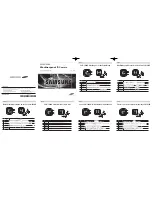
36
Setting Alarm <ALARM>
1
Set <ALARM IN> to the input channel (1 or 2) and
press the SET button.
2
Select <POLARITY> and specify a polarity for the
signal.
3
Select <MOVE> and set the camera to move to
the preset position of the channel where the
alarm has been detected.
The camera will move to “PRESET NO.1” position if an alarm is
detected by ALARM IN1 and to “PRESET NO.2” position when the
alarm is detected by ALARM IN2.
Specifying Alarm Input <ALARM IN>
NO
: Normal Open (When closed, detects an alarm input.)
NC
: Normal Close (When opened, detects an alarm input.)
ALARM SETTING
·ALARM IN
ALARM OUT
MOTION
uAREA
uSENSITIVITY
ZOOM
uZOOM TIME
DURATION
ALARM SIGN
PRESET
MENU
1 y
NO
OFF
SET y
SET y
OFF
5S
5S
OFF
OFF
BACK
·ALARM IN
SET
R
ALARM IN SETTING
·POLARITY
MOVE
ALARM OUT
NO
OFF
OFF
·POLARITY
ON
: The camera moves to “PRESET No.1 or 2” position and stops.
AUTO
: The camera moves to “PRESET No.1 or 2” position, remains there
for the time set in <DURATION> (see page 40), then returns to the
original monitoring mode.
OFF
: The camera remains where it is.
Note:
• Be sure to have a preset position registered for “PRESET NO.2”
before setting ALARM IN2. The MOVE function will not operate if
not registered.
• If <MOVE> is set, zooming (see page 40) will not take place even
at alarm detection.
• If an alarm is detected even if motion is simultaneously detected,
<MOVE> takes priority.
• If an alarm is detected by another input channel when <MOVE> is
operating, the camera moves to the preset position of that
channel, and <MOVE> becomes operative in that position for the
time set in <DURATION>.
ALARM IN SETTING
POLARITY
·MOVE
ALARM OUT
NO
OFF
OFF
·MOVE
L5BL2_BM2_US_XE(GB).book 36 ページ 2006年6月14日 水曜日 午後12時56分
















































